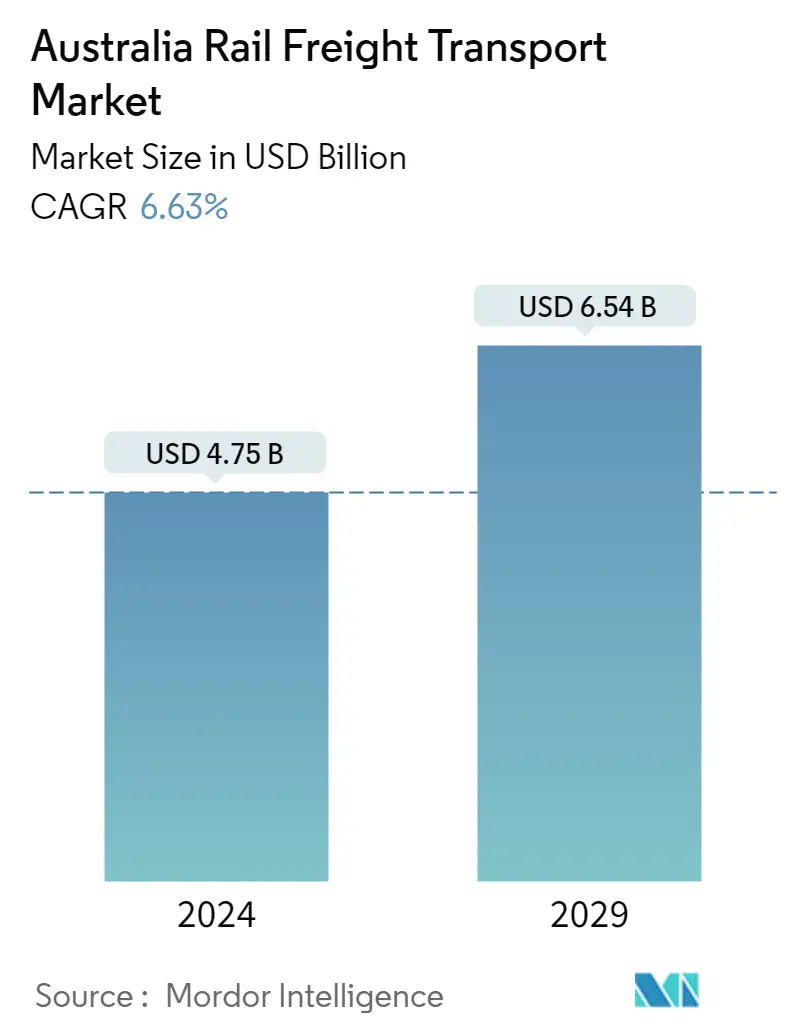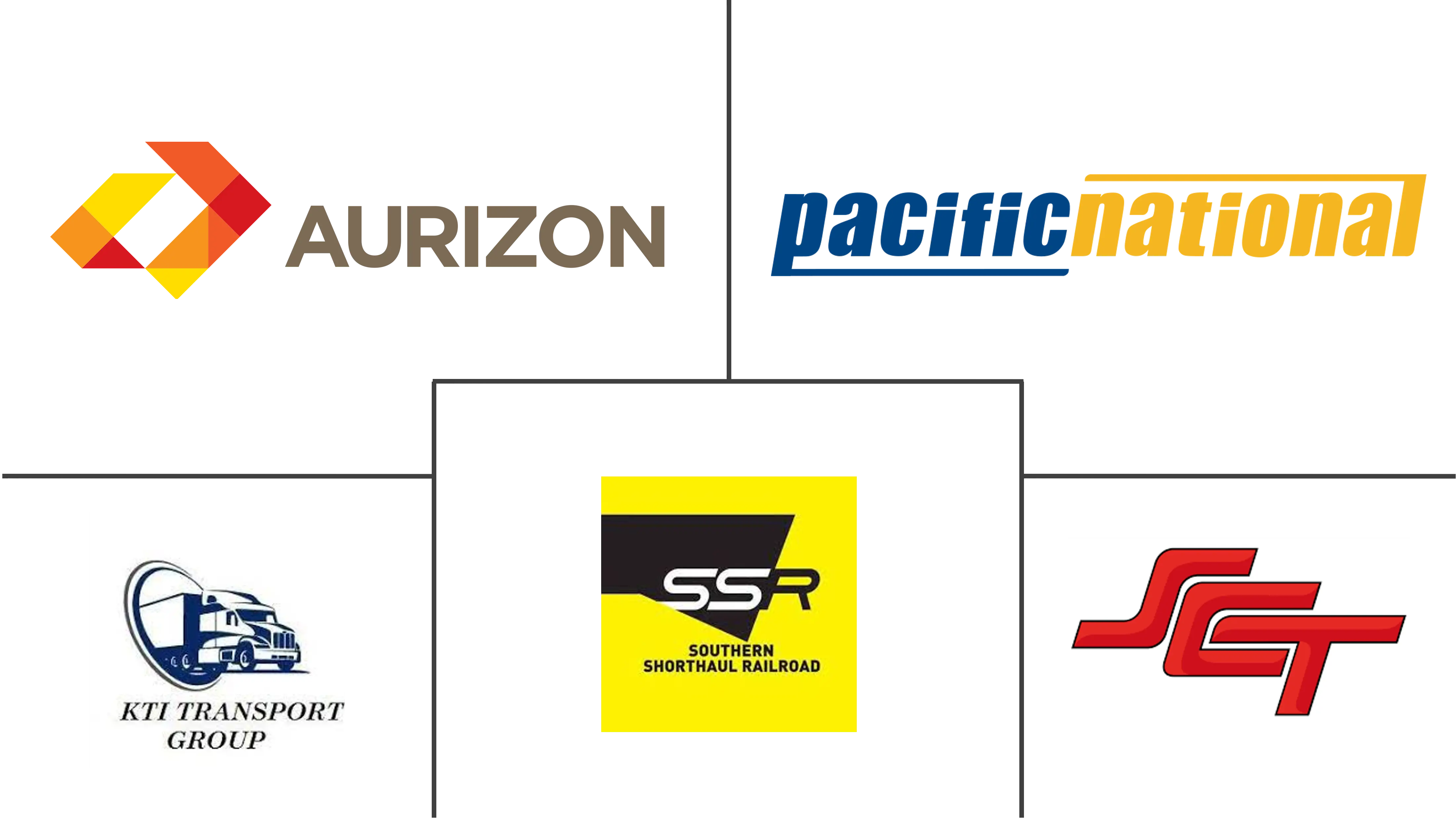Market Size of Australia Rail Freight Transport Industry

| Study Period | 2020 - 2029 |
| Base Year For Estimation | 2023 |
| Market Size (2024) | USD 4.75 Billion |
| Market Size (2029) | USD 6.54 Billion |
| CAGR (2024 - 2029) | 6.63 % |
| Market Concentration | Low |
Major Players
*Disclaimer: Major Players sorted in no particular order |
Australia Rail Freight Transport Market Analysis
The Australia Rail Freight Transport Market size is estimated at USD 4.75 billion in 2024, and is expected to reach USD 6.54 billion by 2029, growing at a CAGR of 6.63% during the forecast period (2024-2029).
Considering the vastness of the nation, Australian freight supply networks are often extensive and diverse.
- A supply chain, in its simplest form, is the web of people, businesses, goods, and services that collects raw materials converts them into finished goods and carries them to their destination. Producers, transporters, customs officers, traders, and inspectors are just a few of the many actors on which they rely. Transporting freight from farms, mines, cities, and ports to domestic and foreign markets will be made simpler by Rail transport.
- Freight forwarders frequently base their decisions on availability and cost when deciding whether to convey freight by road or rail. For the Inland Rail Service Offering, it is crucial that new intermodal terminals are built in Melbourne and Brisbane with enough room to accommodate double-stacked, high-performance trains. In order to complete the development and operation of the Melbourne and Brisbane intermodal freight terminals in time for the start of Rail's full operations, the National Intermodal Corporation will collaborate with the Commonwealth, State Governments, the Australian Rail Track Corporation (ARTC), and industry.
- Economic growth and signals for private sector investment must be supported by investments in Australia's freight-related infrastructure. With the help of the USD 44 million Inland Rail Interface Improvement Program, project ideas are being developed for more efficient supply chains based on rail and upgrades to intersecting national rail lines. In order to implement priority infrastructure projects under the Infrastructure Investment Program, the Australian Government provided USD 150 million in the 2022-23 Budget, building on the success of the II Program.
- Over 80% of Australia's rail freight is exported iron ore and coal, making rail the country's primary carrier of goods and accounting for about 49% of all domestic freight. The Transcontinental Rail Line, which connects the Eastern coastline with the West coast, is one of the largest freight trains in the world. It travels across Australia's immense landmass.
- Australian suppliers of rail technology, equipment, and solutions are open to considering opportunities to collaborate with and represent U.S. businesses because significant investment in Australia's freight and passenger rail infrastructure is expected to continue. In Australia, rail is a USD 26 billion contributor to the national economy and a leader in productivity, innovation, and best practises globally. Some of the heaviest and longest freight trains in the world travel on Australia's heavy haul railways.
Australia Rail Freight Transport Industry Segmentation
From a point of loading or a goods station to a point of unloading, goods are transported by rail. These products, such as coal, building supplies, iron, and steel, are frequently large and heavy. Along with the transportation of large items, the rail freight market also offers this service. Service providers provide value-added services and logistics. Loading and documentation, unloading, services, and packaging are a few of them. As a result, this promotes the growth of the rail freight transportation market.
The Australia Rail Freight Transport Market is Segmented by Cargo Type (Containerized (Intermodal), Non-containerized, and Liquid Bulk), Destination (Domestic and International), and Service Type (Transportation and Services Allied to Transportation). The report offers market size and forecasts for the Australia Rail Freight Transport Market in value (USD billion) for all the above segments.
| Service | |
| Transportation | |
| Services Allied to Transportation (Maintenance of Railcars and Rail Tracks, Switching of Cargo, and Storage) |
| Cargo Type | |
| Containerized (Includes Intermodal) | |
| Non-containerized | |
| Liquid Bulk |
| Destination | |
| Domestic | |
| International |
Australia Rail Freight Transport Market Size Summary
The Australia Rail Freight Transport Market is poised for significant growth, driven by the country's expansive and diverse freight supply networks. Rail transport plays a crucial role in simplifying the movement of goods from various production hubs such as farms, mines, cities, and ports to both domestic and international markets. The development of new intermodal terminals in key locations like Melbourne and Brisbane is essential to accommodate high-performance trains, supporting the Inland Rail Service Offering. This infrastructure expansion is backed by substantial government investments aimed at enhancing Australia's freight-related infrastructure, which is vital for economic growth and attracting private sector investment. The rail sector is a major contributor to Australia's economy, with a significant portion of its freight being exported iron ore and coal, underscoring its importance as a primary carrier of goods.
Australia's rail freight industry is experiencing unprecedented levels of infrastructure investment, with a focus on enhancing rail networks to meet increasing transportation demands. The mining sector, particularly in Western Australia, plays a pivotal role in driving this investment, as it accounts for a substantial portion of the country's exports and workforce. The rail infrastructure is predominantly government-owned, with major market participants like Aurizon Holdings Limited and Pacific National Holdings Pty Ltd leading the industry. The competitive landscape is shaped by strict regulatory requirements and strategic mergers and acquisitions aimed at regional expansion and product line development. Additionally, international collaborations and contracts, such as those with Nokia and Construcciones y Auxiliar de Ferrocarriles, highlight ongoing efforts to modernize and expand rail capabilities, ensuring the sector remains a key driver of Australia's economic growth.
Australia Rail Freight Transport Market Size - Table of Contents
-
1. MARKET DYNAMICS AND INSIGHTS
-
1.1 Current Market Scenario
-
1.2 Market Dynamics
-
1.2.1 Drivers
-
1.2.2 Restraints
-
1.2.3 Opportunities
-
-
1.3 Value Chain/Supply Chain Analysis
-
1.4 Technological Advancements
-
1.5 Government Regulations and Key Initiatives
-
1.6 Elaboration on Key Trade Agreements Related to Rail
-
1.7 Review and Commentary on the Freight Transportation Costs by Rail
-
1.8 Insights into Key End Users of the Rail Freight Sector
-
1.9 Impact of COVID-19 on the Market
-
-
2. MARKET SEGMENTATION
-
2.1 Service
-
2.1.1 Transportation
-
2.1.2 Services Allied to Transportation (Maintenance of Railcars and Rail Tracks, Switching of Cargo, and Storage)
-
-
2.2 Cargo Type
-
2.2.1 Containerized (Includes Intermodal)
-
2.2.2 Non-containerized
-
2.2.3 Liquid Bulk
-
-
2.3 Destination
-
2.3.1 Domestic
-
2.3.2 International
-
-
Australia Rail Freight Transport Market Size FAQs
How big is the Australia Rail Freight Transport Market?
The Australia Rail Freight Transport Market size is expected to reach USD 4.75 billion in 2024 and grow at a CAGR of 6.63% to reach USD 6.54 billion by 2029.
What is the current Australia Rail Freight Transport Market size?
In 2024, the Australia Rail Freight Transport Market size is expected to reach USD 4.75 billion.

